Water scarcity is becoming a pressing reality for gardeners across many regions. Whether you’re dealing with persistent drought conditions, water restrictions, or simply want to create a more sustainable garden, selecting the right low-water gardening seeds and seedlings is your crucial first step. With thoughtful plant selection, you can create a thriving, productive garden that requires significantly less water than conventional varieties.
This guide will walk you through the essential considerations for choosing drought-tolerant plants, understanding seed characteristics, selecting resilient seedlings, and implementing water-smart planting strategies. By the end, you’ll have the knowledge to transform your garden into a water-efficient oasis that produces beautiful results with minimal irrigation.
Understanding Plant Adaptations to Dry Conditions
Plants that thrive in arid environments have evolved remarkable adaptations that allow them to conserve water and survive extended dry periods. Understanding these natural mechanisms can help you identify which seeds and seedlings will perform best in your low-water garden.
Traits of Drought-Resistant Plants
Drought-resistant plants have developed specific physical characteristics that help them conserve moisture and thrive with minimal water. When selecting seeds or seedlings, look for varieties that display these water-saving traits:
- Deep, extensive root systems that can access water stored far below the soil surface
- Small leaf surface area to reduce water loss through transpiration
- Waxy, thick, or hairy leaf coatings that help retain moisture and reflect heat
- Gray or silvery foliage that reflects sunlight rather than absorbing it
- Succulent stems or leaves that store water within plant tissues
- Early maturation cycles that allow plants to complete their lifecycle before the driest season
Plants with these adaptations require less frequent watering and can maintain healthy growth even during periods of drought. By prioritizing these characteristics in your seed and seedling selection, you’ll build a garden foundation that’s naturally aligned with water conservation.
Native vs. Non-Native Species
Plants that are native to your specific region have already adapted to local rainfall patterns, soil conditions, and climate challenges. These indigenous species typically require less supplemental water once established because they’ve evolved in harmony with your local environment.
Benefits of Native Plants:
- Naturally adapted to local rainfall patterns
- Established resistance to regional pests and diseases
- Support local pollinators and wildlife
- Often require minimal soil amendments
- Typically need little to no supplemental water once established
When to Consider Non-Natives:
- When seeking specific edible varieties not native to your region
- For particular ornamental characteristics
- When native options don’t fulfill your garden’s purpose
- When well-adapted drought-tolerant varieties from similar climates are available
While native plants often provide the most water-efficient options, carefully selected non-native species from similar climate zones can also perform well. The key is choosing plants that naturally thrive in conditions similar to yours without requiring excessive irrigation.
Example: Compare water needs between drought-adapted plants and thirsty varieties. A mature cucumber plant may require up to 1-2 inches of water per week during the growing season, while established rosemary might thrive with just 1/4 to 1/2 inch every two weeks. This difference in water requirements can translate to significant water savings across your garden.
Selecting Seeds for Low-Water Gardens
Seeds offer an economical way to start your water-efficient garden while providing access to a wider variety of drought-tolerant plants than you might find as seedlings. When selecting seeds for low-water gardening, understanding packaging information and choosing the right varieties are essential first steps.
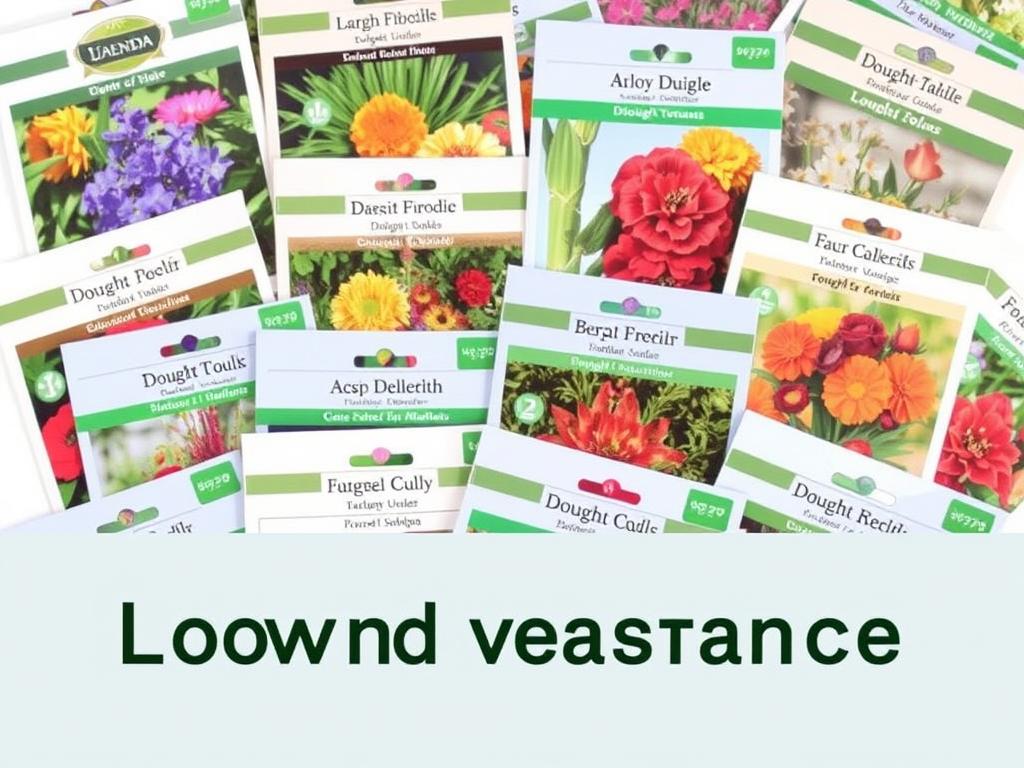
How to Read Seed Packets for Drought Tolerance
Seed packets contain valuable information about a plant’s water requirements and suitability for dry conditions. Here’s what to look for when evaluating seeds for your low-water garden:
- Drought tolerance indicators: Look for terms like “drought-tolerant,” “drought-resistant,” “xeric,” “low-water,” or “water-wise” on the packet
- Sun requirements: Plants labeled for “full sun” often have better drought tolerance than shade-loving varieties
- Days to maturity: Shorter maturation periods can help plants complete their lifecycle before the driest part of the season
- Root depth information: Plants with deeper roots typically access moisture better during dry periods
- Native region: Seeds native to arid or Mediterranean climates often have natural drought resistance
Many seed companies now specifically highlight water requirements or drought tolerance on their packaging. If this information isn’t clearly stated, research the variety online or consult with your local extension office before purchasing.
Top Drought-Resistant Vegetables and Herbs
These plant varieties have proven their ability to thrive with minimal water while still producing abundant harvests. Consider these drought-tolerant options when selecting seeds for your low-water garden:
Vegetables
- Okra – Thrives in hot, dry conditions
- Swiss Chard – Continues producing with minimal water
- Tepary Beans – Ancient drought-resistant legume
- Armenian Cucumber – More drought-tolerant than standard cucumbers
- Eggplant – Needs less water once established
Herbs
- Rosemary – Mediterranean herb with minimal water needs
- Thyme – Thrives in dry, sunny locations
- Sage – Drought-resistant perennial herb
- Oregano – Requires little water once established
- Lavender – Prefers dry conditions once rooted
Flowers & Companions
- Sunflowers – Deep roots access subsoil moisture
- Yarrow – Drought-tolerant native perennial
- Nasturtium – Edible flowers with low water needs
- Marigold – Pest-repelling with minimal water requirements
- Zinnia – Heat and drought tolerant annual
Step-by-Step: Assessing Seed Suppliers for Climate-Specific Varieties
Not all seed suppliers offer varieties well-suited to low-water gardening. Follow these steps to identify sources that specialize in drought-tolerant seeds:
- Research suppliers in similar climate zones – Seed companies based in arid regions often specialize in drought-adapted varieties
- Look for climate-specific collections – Many suppliers offer “drought-tolerant” or “water-wise” seed collections
- Check for regional adaptation information – Quality suppliers indicate which growing zones or conditions their varieties perform best in
- Seek out heirloom and landrace varieties – These often have better regional adaptation than highly commercialized hybrids
- Contact your local extension office – They can recommend suppliers with varieties proven successful in your specific climate
Pro Tip: Seeds saved from plants that have thrived in your garden for multiple seasons will gradually adapt to your specific microclimate and water conditions. Consider implementing a seed-saving program for your most successful low-water varieties.
Choosing the Right Seedlings
While starting from seed offers the widest variety options, purchasing seedlings can give your low-water garden a head start. However, not all nursery seedlings are created equal when it comes to drought tolerance. Knowing what to look for can help you select plants that will thrive with minimal irrigation.
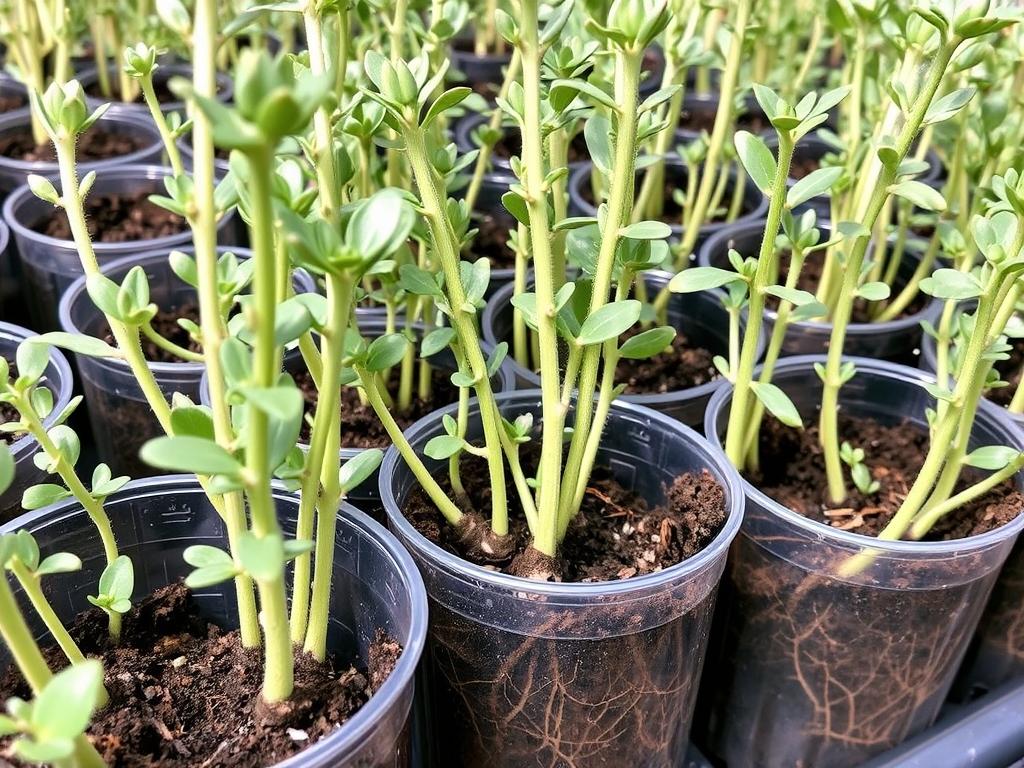
Signs of Healthy, Drought-Adapted Seedlings
The physical characteristics of a seedling can tell you a lot about its potential drought tolerance and overall health. When browsing nursery plants, look for these indicators of water-efficient seedlings:
- Thick, sturdy stems rather than thin, leggy growth
- Compact growth habit with appropriate spacing between leaves
- Deep green leaves without yellowing (unless variegation is normal for the variety)
- Minimal leaf surface area relative to plant size
- Well-developed root system that holds the soil together when gently removed from the pot
- No signs of stress such as wilting, brown leaf edges, or pest damage
- Not root-bound – avoid plants with roots circling the container
Healthy seedlings with these characteristics will establish more quickly in your garden and develop the robust root systems necessary for drought resilience. Avoid purchasing plants that already show signs of water stress, as they may have suffered root damage that will limit their future performance.
Questions to Ask Nurseries
Nursery staff can provide valuable information about the water requirements and growing conditions of their plants. Don’t hesitate to ask these questions when selecting seedlings for your low-water garden:
“Were these seedlings hardened off or grown with limited water?”
“Which varieties have proven most drought-tolerant for local gardeners?”
“How long have these plants been in their containers?”
“What soil mix were these grown in, and is it similar to my garden soil?”
“Do you have any native or specifically drought-adapted varieties?”
Nurseries that specialize in native plants or water-wise gardening will often have staff with specific knowledge about low-water varieties. These specialized nurseries are excellent resources for finding seedlings pre-adapted to thrive with minimal irrigation.
Warning: Avoid purchasing seedlings with yellowing leaves, root circling the bottom of the pot, or signs of wilting. These stress indicators suggest the plant may already have compromised root systems that will struggle to establish in your garden.
Water-Smart Planting Strategies
Even the most drought-tolerant seeds and seedlings need proper planting techniques to maximize their water efficiency. How and where you plant can significantly impact how much supplemental irrigation your garden will require.
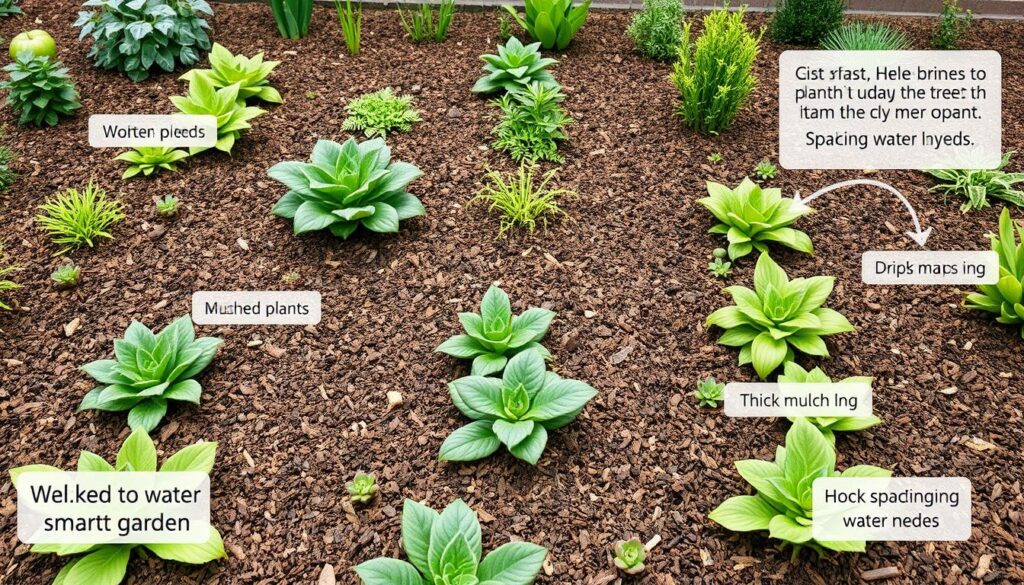
Soil Preparation for Water Retention
The foundation of any water-efficient garden is soil that can effectively absorb and retain moisture while still providing good drainage. Before planting your drought-tolerant seeds or seedlings, prepare your soil with these water-conservation techniques:
- Add organic matter – Compost, aged manure, or leaf mold improves both water retention and drainage
- Avoid excessive tilling – Minimal soil disturbance preserves soil structure and beneficial organisms
- Create slight depressions around plants – These “watering basins” help direct water to root zones
- Apply mulch immediately after planting – A 2-3 inch layer reduces evaporation and moderates soil temperature
- Consider adding water-retaining amendments – Materials like coconut coir can help sandy soils hold moisture longer
Well-prepared soil acts like a reservoir, holding moisture within reach of plant roots while allowing excess water to drain away. This balance is crucial for developing strong root systems that can access soil moisture even during dry periods.
Vertical Gardening Tips to Reduce Evaporation
Vertical gardening isn’t just space-efficient—it can also create microclimates that help conserve water in your garden. Consider these vertical strategies to enhance water efficiency:
- Install trellises on the west side of garden beds to provide afternoon shade
- Group climbing plants to create humidity pockets that reduce evaporation
- Use vertical structures to direct morning sun and afternoon shade where needed
- Position water-loving plants at the base of vertical structures where moisture collects
- Install drip irrigation at multiple heights on vertical gardens for efficient watering
Vertical elements can create beneficial microclimates by providing shade, reducing wind exposure, and increasing humidity—all factors that help reduce water loss from your garden soil.
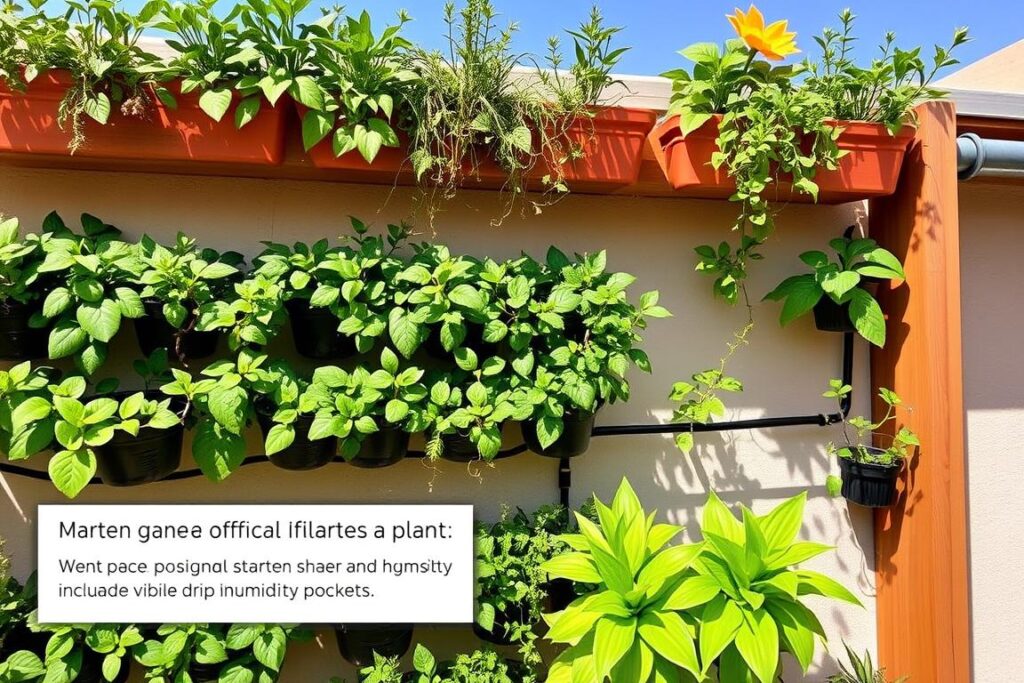
Companion Planting for Water Conservation
Strategic plant groupings can create synergies that reduce overall water requirements. Consider these companion planting approaches for your low-water garden:
Water-Sharing Companions:
- Tall + Short Plants: Corn providing shade for beans and squash (Three Sisters method)
- Deep + Shallow Roots: Tomatoes alongside shallow-rooted basil
- Ground Covers + Tall Plants: Purslane under peppers to reduce soil evaporation
Hydrozoning Strategies:
- Group by water needs: Keep high, medium, and low water plants separated
- Create moisture gradients: Plant thirstier varieties at the bottom of slopes
- Edge with drought-tolerant plants: Use rosemary or lavender as border plants
Thoughtful companion planting creates natural synergies where plants help each other access and conserve water. By grouping plants with similar water needs together (hydrozoning), you can water more efficiently and avoid over-irrigating drought-tolerant species.
“The most water-efficient garden is one where every plant is in the right place—receiving exactly the light, soil, and moisture conditions it has evolved to thrive in.”
Maintenance and Long-Term Success
Selecting appropriate seeds and seedlings is just the beginning of your low-water gardening journey. Proper maintenance practices are equally important for long-term water efficiency and plant health.
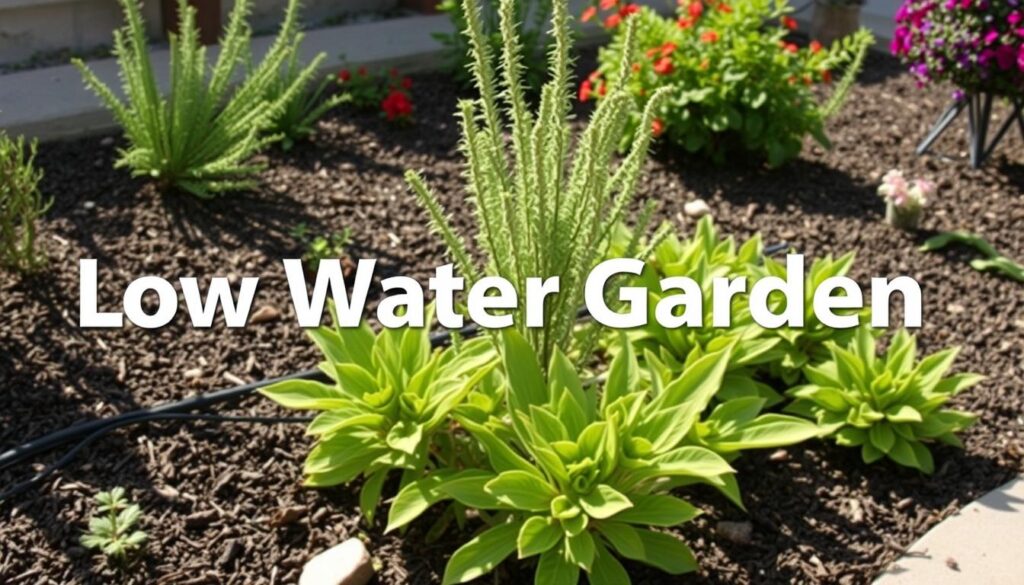
Watering Schedules for Establishment
Even drought-tolerant plants need consistent moisture while establishing their root systems. Follow these guidelines to help your low-water plants develop drought resilience:
- Seeds: Keep soil consistently moist until germination, then gradually reduce frequency
- New seedlings: Water deeply every 2-3 days for the first two weeks after transplanting
- Weeks 3-4: Extend to every 3-4 days, watering deeply each time
- Months 2-3: Transition to once weekly deep watering
- After establishment: Water only when soil is dry 2-3 inches below the surface
The key is to water deeply but infrequently, encouraging roots to grow downward in search of moisture. This develops more drought-resistant plants than frequent shallow watering, which promotes surface root development.
Monitoring Soil Moisture
Learning to accurately assess soil moisture is an essential skill for water-efficient gardening. Rather than watering on a fixed schedule, adjust your irrigation based on actual soil conditions:
Manual Checking Methods:
- Finger test: Insert finger 2-3 inches into soil; water only if dry
- Wooden stick method: Insert unpainted wooden stick into soil; if it comes out clean, soil is dry
- Soil core sample: Use a trowel to check moisture at root depth
Tools for Precision:
- Moisture meters: Provide accurate readings at various depths
- Smart irrigation controllers: Adjust watering based on weather and soil conditions
- Rain gauges: Help track natural precipitation
By monitoring actual soil moisture rather than following a calendar schedule, you’ll avoid both overwatering and underwatering. This responsive approach ensures plants receive exactly the water they need—no more, no less.
Efficient Irrigation Tools
The right irrigation tools can dramatically reduce water consumption while keeping your plants healthy. Consider these water-efficient options:
- Drip irrigation systems: Deliver water directly to root zones with minimal evaporation
- Soaker hoses: Provide slow, deep watering along plant rows
- Ollas: Buried clay pots that slowly release water directly to roots
- Watering wands with adjustable flow: Allow precise hand-watering when needed
- Rain barrels: Capture and store rainwater for use during dry periods
- Mulch: Not a tool, but essential for reducing evaporation from soil
Investing in efficient irrigation tools pays dividends through water savings, reduced plant stress, and lower water bills. The most effective systems deliver water slowly and directly to the root zone, minimizing runoff and evaporation.
Seasonal Adjustments: Remember to modify your watering approach as seasons change. Spring and fall typically require less supplemental water than summer. Winter watering needs vary dramatically by climate—some regions may need occasional winter irrigation while others receive sufficient natural precipitation.
Conclusion
Creating a thriving low-water garden begins with thoughtful selection of seeds and seedlings adapted to dry conditions. By choosing plants with natural drought tolerance, preparing your soil properly, and implementing water-efficient maintenance practices, you can create a beautiful, productive garden that thrives with minimal irrigation.
Remember that the most successful water-wise gardens develop over time. As you observe which varieties perform best in your specific conditions, you can gradually refine your plant selection and care routines. The reward is a resilient garden that remains vibrant even during water restrictions or drought conditions.
With the knowledge and strategies outlined in this guide, you’re well-equipped to make smart choices for your low-water garden. Your efforts not only conserve a precious resource but also contribute to more sustainable local ecosystems and communities.
Ready to Start Your Low-Water Garden?
Download our free “Drought-Resistant Plant Selection Checklist” to help you choose the perfect low-water varieties for your specific growing conditions. This comprehensive guide includes regional recommendations, water requirement ratings, and companion planting suggestions.
Frequently Asked Questions
How much water do seedlings need compared to established plants?
Seedlings require more frequent watering than established plants because their root systems are shallow and still developing. While mature drought-tolerant plants might thrive with water once every 1-2 weeks, seedlings typically need consistent moisture until they develop deeper roots. During the first 2-3 weeks after transplanting, water seedlings every 2-3 days, then gradually extend the time between waterings to encourage deeper root growth.
Can I grow vegetables in a low-water garden?
Yes, many vegetables can thrive in low-water conditions, especially those native to arid or Mediterranean climates. Good choices include tomatoes (once established), peppers, eggplant, okra, Swiss chard, bush beans, and many herbs. Focus on varieties specifically bred or selected for drought tolerance, and consider using techniques like deep mulching and ollas (buried clay pots) to reduce water requirements further.
How do I transition existing plants to use less water?
Transition plants to lower water conditions gradually over several weeks to avoid shock. Begin by extending the time between waterings while maintaining the same water volume. This encourages roots to grow deeper in search of moisture. Add a thick layer of mulch to reduce evaporation, and consider applying compost to improve soil water retention. Some plants may never fully adapt to low-water conditions, so be prepared to replace particularly thirsty varieties with more drought-tolerant alternatives.
What’s the best time to plant drought-tolerant seeds?
For most regions, plant drought-tolerant seeds in early spring or fall when temperatures are moderate and natural rainfall is more likely. This gives plants time to establish strong root systems before facing summer heat or winter cold. In very hot climates, fall planting is often most successful for drought-tolerant perennials, allowing them to develop roots during the cooler months. Always check seed packets for specific timing recommendations for your growing zone.
Will is a vertical gardening enthusiast and sustainable cultivation specialist with a passion for helping people grow fresh food in small spaces and dry climates. With years of hands-on experience testing smart irrigation systems, optimizing urban gardens, and exploring eco-friendly solutions, this author shares clear, practical tips to turn any corner into a productive garden. Whether on a sunny balcony or in a compact backyard, Will helps readers save water, maximize space, and enjoy healthy harvests year-round. When not tending to his plants, you’ll find him sipping herbal tea and sketching ideas for new sustainable projects.

